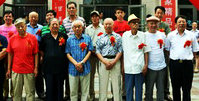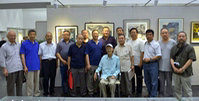- 公告
- 展览
- 讲座
- 笔会
- 拍卖
- 活动
国际版画艺术巡展在泰达当代艺术博物馆展出
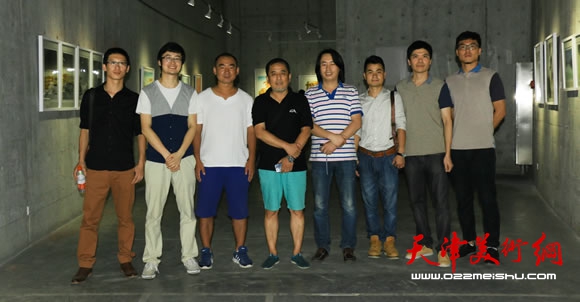
天津美术学院版画系主任范敏教授与泰达当代艺术博物馆馆长刘建国、展览统筹蒋伟及参展艺术家郑建辉、关伟伟、何吉庆、桂江合影,左起:何吉庆 、蒋伟、崔凯(观众)、范敏、刘建国、桂江、郑建辉、关伟伟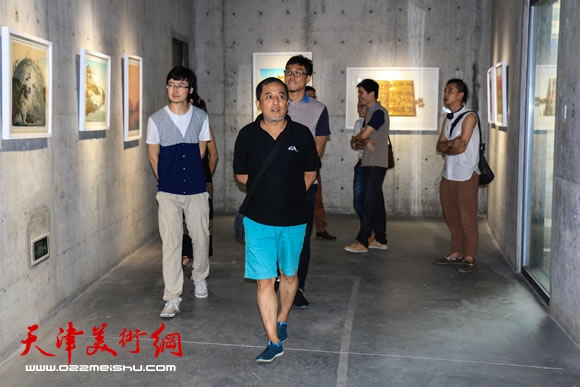
天津美术学院版画系主任范敏教授步入展厅观看展览
天津美术学院版画系主任范敏教授(中)在展览统筹蒋伟(右)陪同下观看展览
范敏教授与展览统筹蒋伟在一起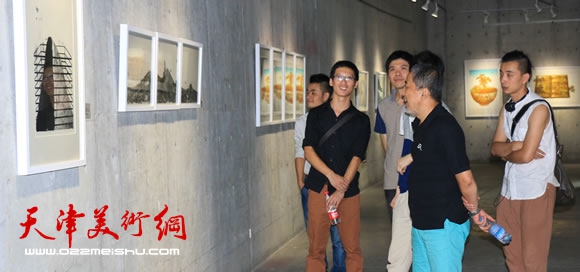
范敏教授与参展艺术家交流
天津美术学院版画系主任范敏教授与艺术家桂江合影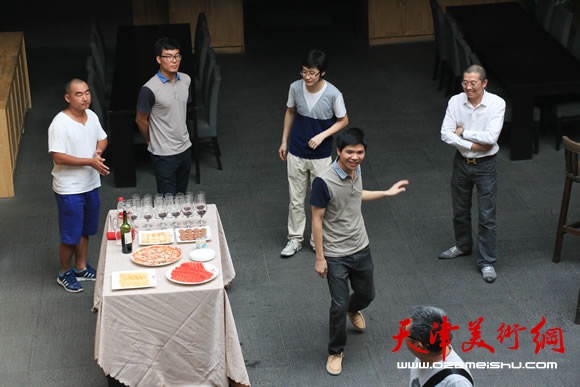
策展人徐子林(右)、展览统筹蒋伟(中)及参展艺术家郑建辉(前)等在展览开幕式现场
展览现场
展览现场
展览现场
展览现场
天津美术网讯 近日,版托邦——国际版画艺术巡展天津站在泰达当代艺术博物馆展出。据悉,此次展览将展出关伟伟、姚元鲁等26名国内外版画家的100幅版画作品。天津站是此次艺术巡展的第一站,接下来还将在北京、上海展出,展览将持续到9月30日。
版托邦来自乌托邦
为何此次展览命名为“版托邦”?泰达当代艺术博物馆馆长徐子林告诉记者,“版托邦”来自“乌托邦”,代表着一种对版画艺术的理想,为了理想做出的尝试。他解释道:“因为版画艺术家和国画、油画、书法等类型的艺术家有一个很大的不同,版画创作要有版画印刷机,或者有一个较大的创作空间,对创作有一定条件的限制,有很多版画专业的学生在毕业后放弃从事版画创作,或者说转到别的类型创作。正是因为有一定地点、条件的限制,版画艺术家们在社会上的生存和发展很不容易,我们这次展览希望能让版画艺术为更多人所知,表达一种版画艺术家们的信念。”
丝网版画成亮点
“这次展览是很多国外版画艺术家和国内一些年轻版画艺术家的作品群展,展出的版画形式比较丰富,包含多数的版画品种,包括石版、木版、铜板、丝网版画,也包括多种版画技法,可以说是不同地区、风格多样的版画艺术家们的一次交流。”徐子林说。
相比于木版、铜板、石版版画,丝网版画这个版画品种并不为大众所熟悉。此次展览展出了国外一些小型的丝网版画。徐子林说:“我们刻意回避展出国内丝网版画这个版种,过去几年里,丝网版画在中国的发展出现一些不太好的现象。一些艺术家自己不做版画,利用照相制版或者各种其它做法,找人代替做版画,称之为丝网版画。对于版画来说,强调的是艺术家自己雕版、印制的艺术原创性。这一做法让目前的国内丝网版画鱼龙混杂,我们这次的展览就是想让滨海艺术爱好者,体验到纯粹的丝网版画表达出的艺术之美。”(黄静 何沛霖)

郑建辉《境——大器》凸版81.5x65cm 2011年
关伟伟《土堆》平版49cmx65cm 2013年
桂江《相对风景二》凹版30cmx30cm 2013年
何吉庆《那不是山》平版40cmx57cm 2014年
姚元鲁 《心相系列NO.1》 平版37cmx28cm 2012年
龙凯 《戏鸟》 凹版50cmx39.5cmx6 2013年
Hristo Naidenov 凹版 保加利亚
Martin R. Baeyens 漏版 比利时
Natalija Cernetsov 凹版 拉脱维亚
Peter Velikov 凹版 保加利亚
Roman Sustov 凹版 白俄罗斯
Vladimir Zuev 凹版 俄罗斯
Vladimir Zuev 凹版 俄罗斯
展览时间:2014年8月16日—2014年9月30日
展览地点:泰达当代艺术博物馆2号展厅 3号展厅
出 品 人:马惠东
策 展 人:徐子林
展览统筹:蒋伟
国际版画艺术巡展-天津站 前言
版画艺术的发展起源于雕版印刷术的发明,而雕版印刷术则是中国最骄傲的四大发明之一,正是由于印刷术和造纸术的广泛流传,加速推动了东西方人类文明的变革……雕版印刷从诞生起,就是为了实现传播的便捷性和复制性,这导致雕版刻印者首先以一个手工艺人和工匠的身份处于印刷产业链的末端:只是为画作作者的画稿完成雕刻、套印的复制工序。显然,处于此种状态下的雕版印刷不能成为独立版画艺术。直到后来,以版画实现艺术创作的风气兴起,创作者从版画的角度构思、雕刻、套印等全过程亲力亲为,并且形成各自的创作理念和风格,“版画”才终于可以被称为相对独立的版画艺术。
即便如此,从传统的角度看待版画,让版画得以存在和发展的根本原因,仍然要归于版画的实用性,其主要用途则体现在服务宗教和民俗生活上。现在可考证的最早版画是一千多年前,敦煌莫高窟出土的《金刚经》卷首佛画,则是典型的木刻版画。而后来民间盛传的版印年画,比如天津的杨柳青、苏州的桃花坞等地,都曾一度是民俗版画的艺术重镇。
雕版印刷术传入欧洲,经过文艺复兴时期的发展,将印刷术改良和绘画艺术高度融合,诞生了一大批重要的版画艺术家和版画作品。欧洲早期版画以复制当时流行的名画为主,特别是钢笔画和素描,题材则主要描绘宗教、神话故事。十五世纪末北欧文艺复兴的丢勒(Albrecht Durer,1471—1528)和霍尔滨(Hans Holbein,1497—1543)则是其中重要的代表艺术家。特别是丢勒创作的版画,刀法严谨、线条细密,无论是木版或是铜版,画面都以黑或白的密集线条构成,却能充分体现形体的内部结构、光影变化和立体透视关系,同时也能准确地描绘出物体的材质质感,可以说,丢勒是十六世纪最受欢迎的版画艺术家之一。
回顾版画的诞生和发展,我们甚至可以将版画当作实用艺术来对待,但是到了今天,我们似乎没有理由再以“实用”的功能性来要求版画的创作。那么,不再“实用”的版画如何应对今天的文化现实?
在版画中讨论版画
首先,版画属于平面绘画的一种,需要通过事先制版,再套色印制两个部分完成。版画和绘画最大的不同不同之处在于,版画是间接艺术(indirect art),作者不在画面上直接作画。从这个角度看,制版(刻板)在版画艺术中起决定因素,因为套印作为后期印制,可以通过不断调试而最终达到创作目标,但如果原版不佳,就算套印技术再高,也无法达到预期的创作目标。
所以讨论版画艺术的高低,首先要面对制版(刻板)最根本的问题,这同样也是版画最本质的特征,也是区别于直接绘画艺术的重要特性。
这同样也提出了新问题,那些通过照相制版的“复制版画”可不可以放在版画艺术的范畴中进行讨论?我的观点是,这些没有直接创作制版(刻板)的“版画”只能称为复制品,它们只是利用了版画的制作工艺复制了一些产品。
同样,正在流行的“数码版画”也面临质疑,严格地说,“数码版画”只能归位数码复制品,至于是否具备艺术价值,则要放在数码艺术的范畴中讨论(这种讨论和版画没有关系)。
在版画中讨论当代艺术和在当代艺术中讨论版画
什么样的版画作品才能被称为当代艺术,或者当代艺术中有版画品种分类的必要吗?显然,这是一个伪命题,因为当代艺术不仅不以画种为评判基础,而是彻底抛弃、混搭、模糊了一切固有的视觉形式。我们只能讨论这件作品是不是当代艺术作品,而无需考虑它的材质、品类、形式等外在特征。这恰恰也说明,一件当代艺术作品可以是版画,也可以是任何一个画种或形式。
把版画和当代艺术关联,这是我对版画艺术家的期许,而非对版画自身的苛求。因为在我看来,一个有时代使命感的艺术家在面对自己的创作时,需要将自己设置在当代艺术的范畴中,需要关注艺术观念和时代、社会、民生、环境发生关系,同时还要体验对生命的终极关怀……在这个前提下,一切外在的形式都不重要,一切形式都有可能。于是,版画艺术在当下也有了值得讨论和探索的多种可能性。
波普艺术家安迪·沃霍尔(Andy Warhol,1928-1987)充分利用了版画的复制性和工业化生产的复制性做了完美的呼应,不仅如此,沃霍尔还挑战了版画的基本特性(间接艺术),在已经印制好的版画上再次绘制,从而创造出每一幅都不相同的独幅版画。或许我们可以拒绝将这些“丝网版画”称为严格意义上的版画,但是这已经不再重要,因为当代艺术已经不再关注这些无需讨论的枝枝节节了。
我热切的呼唤这样的艺术家出现。 (徐子林)
Print Utopia International Print Art Tour——Tianjin
Preface
Printmaking art originated from the invention of woodblock printing which is one of the four proud great inventions of ancient
Nevertheless, from the traditional point of view, the root cause of existence and development of printmaking still need to be attributed to the practicability of prints whose function realized in religion and folk custom. Now the earliest print can be traced back is a typical woodcut in “Diamond Sutra” as front painting created 1000 years ago unearthed in Tunhuang Mogao Grottoes. Afterwards the printed new-year print art workshops became popular, Yangliuqing in
After woodblock printing introduced to
Reviewing the birth and development of print artworks, we can even treat it as practical art. But for today, it seems that it’s not suitable for us to ask print art for practical functions. Then how can we face the facts of current culture? I discuss this from two aspects below:
Discussing print in print
Firstly, print belongs to plane painting, and needs to go through plate making in advance, then finish after chromatograph. The biggest difference between prints and paintings is that print is indirect art and artist does not create on it. From this point of view, plate making is the determinant in print art. Because chromatograph as the ending step can be adjusted, but if the original plate is poor, even print skills is high, the expectant creation target can’t be reached.
So discussing about print art needs to face the root issue of plate making, it’s also the print making’s most essential feature and the significant character differing from direct art.
A new issue is raised up, that can we put “copy prints” via photogravure into print art category to discuss? In another word, those prints do not created directly can be only called duplications and they are only a matter of products produced by print making methods.
Similarly, the digital print in popular also faced with questions. Strictly speaking, digital print can be only called digital duplication, and as for art of value it containing, need to be discussed in digital art category (this kind of discussion has no relationship with print art).
Discussing Contemporary Art in Print Art and Discussing Print Art in Contemporary Art
What kind of print artwork can be called contemporary art? Or is it necessary to make print art as one classification of contemporary art? Obviously, it’s a pseudo-proposition. We can only discuss a certain artwork instead of a certain contemporary artwork, and no need to consider its external features such as material, category, form, etc. This just goes that a contemporary artwork can be a print artwork or any other kind of painting or form.
Making relevance between print art and contemporary art is my expectation to print artists instead of print artworks. Because in my opinion, when an artist with mission feeling facing with his creation, he needs to located himself in contemporary category, focus on relationship between art concepts and era, society, people’s livelihood and environment. At the same time, he needs to experience the ultimate care for life. In this context, all other external forms are not important and all kinds of forms are possible. Hence, print art has various possibilities to be discussed and explored, which are valuable in present.
The pop artist Andy Warhol (1928-1987) made the best of duplication of print art and echoing the industrial production’s duplication perfectly. Moreover, Warhol challenged the basic feature of print art (indirect art) and designed on the finished prints, thereby he created unique prints. Maybe we refuse to name those silk screen prints as proper prints, but it’s no longer important because contemporary art has no longer paid attention to details that don’t need to be discussed.
I eagerly call the appearance of these artists.
By Xu Zilin

- • 天津杂项藏家张耀庭:藏天地间那杆良心秤
- • 刘曦林谈第十二届全国美展中国画评审工作
- • 法外求化—王俊生大写意画展于11日举行
- • 《王俊生画集》由天津人美出版社出版
- • 第五届国际文化创意展交会闭幕 文化创意改变生活
- • 天津五大道疙瘩楼:可以吃的博物馆
- • 南开大学诗词楹联学会、南开大学书画社慰问交警
- • 著名书法家封俊虎走进《中国正能量》解读学术观点
- • 组图:天津画马名家蔡长奎收康柏林为徒
- • 天津民间艺术精品博览会展位全部售出
- • 全套漫画版中国四大名著由天津人民美术出版社发行
- • 张映雪家人向杨柳青木版年画博物馆捐赠珍贵年画
- • 画家马寒松畅谈作画心路:真情使然 水到渠成
- • 刘奎龄画派艺术作品展今开幕 汇集20多位画家

-
 赵国经、王美芳
¥ 0
赵国经、王美芳
¥ 0
-
 王学仲:《垂杨饮马》
¥ 0
王学仲:《垂杨饮马》
¥ 0
-
 何家英:《醉艳》
¥ 0
何家英:《醉艳》
¥ 0
-
 萧朗:难忘十月醉金秋
¥ 0
萧朗:难忘十月醉金秋
¥ 0


